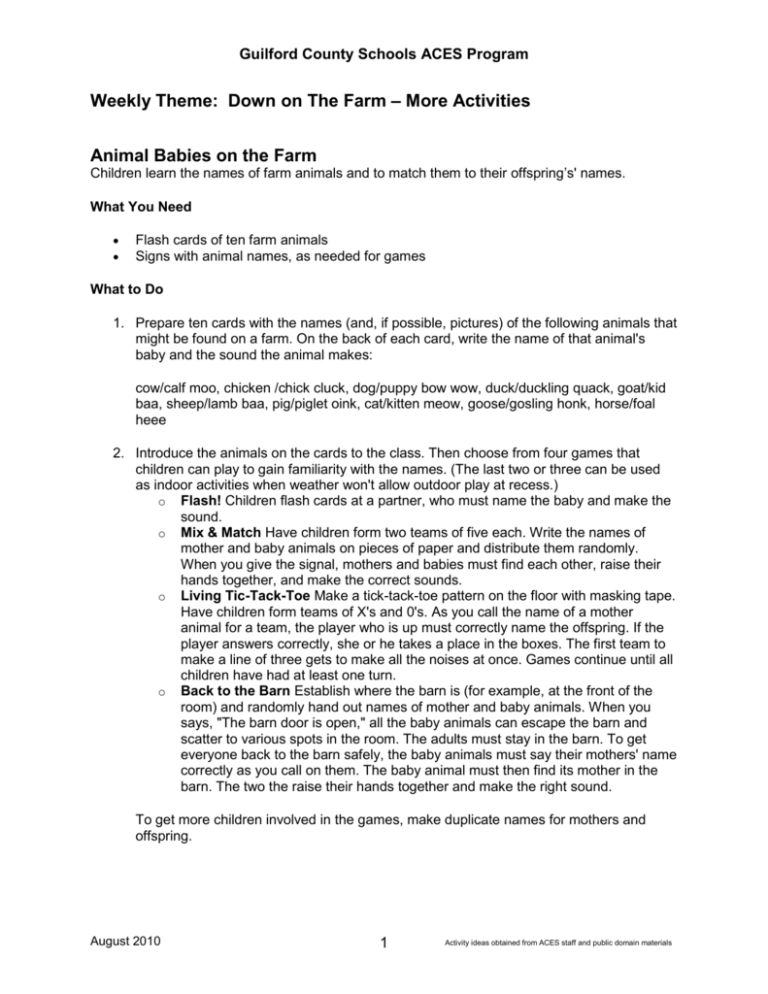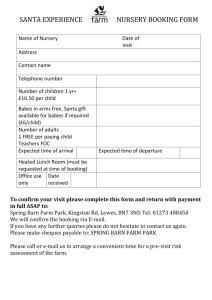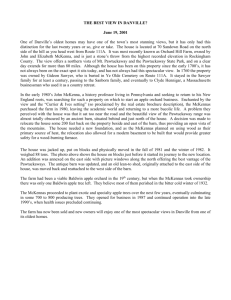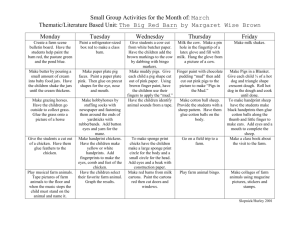Activities
advertisement

Guilford County Schools ACES Program Weekly Theme: Down on The Farm – More Activities Animal Babies on the Farm Children learn the names of farm animals and to match them to their offspring’s' names. What You Need Flash cards of ten farm animals Signs with animal names, as needed for games What to Do 1. Prepare ten cards with the names (and, if possible, pictures) of the following animals that might be found on a farm. On the back of each card, write the name of that animal's baby and the sound the animal makes: cow/calf moo, chicken /chick cluck, dog/puppy bow wow, duck/duckling quack, goat/kid baa, sheep/lamb baa, pig/piglet oink, cat/kitten meow, goose/gosling honk, horse/foal heee 2. Introduce the animals on the cards to the class. Then choose from four games that children can play to gain familiarity with the names. (The last two or three can be used as indoor activities when weather won't allow outdoor play at recess.) o Flash! Children flash cards at a partner, who must name the baby and make the sound. o Mix & Match Have children form two teams of five each. Write the names of mother and baby animals on pieces of paper and distribute them randomly. When you give the signal, mothers and babies must find each other, raise their hands together, and make the correct sounds. o Living Tic-Tack-Toe Make a tick-tack-toe pattern on the floor with masking tape. Have children form teams of X's and 0's. As you call the name of a mother animal for a team, the player who is up must correctly name the offspring. If the player answers correctly, she or he takes a place in the boxes. The first team to make a line of three gets to make all the noises at once. Games continue until all children have had at least one turn. o Back to the Barn Establish where the barn is (for example, at the front of the room) and randomly hand out names of mother and baby animals. When you says, "The barn door is open," all the baby animals can escape the barn and scatter to various spots in the room. The adults must stay in the barn. To get everyone back to the barn safely, the baby animals must say their mothers' name correctly as you call on them. The baby animal must then find its mother in the barn. The two the raise their hands together and make the right sound. To get more children involved in the games, make duplicate names for mothers and offspring. August 2010 1 Activity ideas obtained from ACES staff and public domain materials Guilford County Schools ACES Program On the Farm or at the Zoo? In this activity, children will discuss the relationship between people and different kinds of animals. Then they will categorize animals into two groups, farm animals and zoo animals. What You Need Pictures of various wild and domestic animals (optional) Farm Animals and Zoo Animals (print and copy) What to Do 1. Discuss with children the fact that people have different relationships with different animals. For example, because cows are more tame, they can be kept on a farm, while tigers and other wild animals cannot. Ask children to think about the kinds of animals that can live on a farm and the kinds that may live in a zoo. You may want to discuss why some animals live on a farm (horses help farmers do work, cows give milk, hens lay eggs, etc.) and other animals may be kept in a zoo (they are wild and most people might not see and learn about them otherwise.) 2. Then write Farm at the top of a piece of chart paper and Zoo at the top of another. Name each animal from the list below and ask children to tell you whether it lives on a farm or in a zoo. If you have a matching picture, hold it up as you say the animal's name. cow, tiger, lion, horse, hen, bear, rooster, giraffe, elephant, duck, rhinoceros (rhino), sheep, goat, hippopotamus (hippo), pig, kangaroo List the animals on the chart that the children indicate. If they are having trouble deciding where a particular animal should be listed, revisit your initial about farm animals and zoo animals. 3. Next, tell children that they will play an animal roundup game. Divide the class into three groups: zookeepers, farmers, and animals. Explain that some children are going to pretend to be animals that have wandered away from the zoo and the farm, so the children who are zookeepers and farmers must bring the animals back to their respective homes. Designate one area of the classroom to be a farm and another to be the zoo. Pass out the labels from the Farm and Zoo Animals sheet (helping children to read words as necessary). Then have the farmers and zookeepers round up their animals. Repeat the activity with new farmers and zookeepers. Milk Carton Barn What You Need: Small Milk Carton (make sure to clean the milk cartons thoroughly) Paint paper or cardboard What You Do: Cut the milk carton to make doors. Then give the children the milk cartons and let them paint them as a barn. You might want them to do this on paper or cardboard as it can get messy. August 2010 2 Activity ideas obtained from ACES staff and public domain materials Guilford County Schools ACES Program Above and Below Vegetable Garden Materials: 12x18" white paper, sharpie, crayons Bring in several root vegetables. Discuss the textures and colors. Ask students to pretend they have a magical camera - the camera is very thin, and you can slide it into the ground. Take a picture, and you can see what is going on below the surface. Draw a horizon line and below it we draw the vegetables. Have students do a rubbing on a cement wall with brown crayon-- on the bottom half -- to show dirt Paper Lunch Bag Cow Puppet What you will need: White paper lunch bags, white typing paper, tape, glue sticks, and black crayons. What to do: 1. Before class print out the cow head pattern and the cow leg pattern and make copies. 2. Have students cut out the patterns. 3. Show the students how to fold down the corners of the bottom of the bag and tape them down. 4. Glue the cows head onto the bottom of the bag. 5. Color the tongue and glue it under the folded bottom of the bag. 6. Glue the legs to the back of the bag and color spots on the cow. August 2010 3 Activity ideas obtained from ACES staff and public domain materials Guilford County Schools ACES Program August 2010 4 Activity ideas obtained from ACES staff and public domain materials





